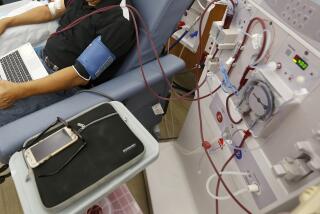Parents Face a Fearsome Choice if Transplant Fails
- Share via
--The parents of two toddlers with kidney disease are spending most of their time in cities hundreds of miles apart as they await the day each will give up a kidney to save the life of a daughter. Charles Richardson works four days a week in Aurora, Colo., as deputy city attorney, then flies to Minneapolis each Thursday night for a long weekend with his family. Kim Richardson and daughters Dianna, 2, and Kristin, 3, are living at a “transplant house” at University of Minnesota Hospitals. Dianna already has had both kidneys removed. The surgery to transplant her mother’s kidney is scheduled for Jan. 23. Meanwhile, the little girl undergoes kidney dialysis three times a week, each treatment lasting six hours. Kristin looks as healthy as any other 3-year-old, but she too is afflicted with the hereditary nephrotic syndrome, a rare and lethal kidney disease. Charles Richardson plans to give a kidney to Kristin. The question of which child will get his kidney if Dianna’s body rejects the mother’s is a volatile one that the couple has not resolved. The father, if faced with the choice, would save his kidney for the healthier Kristin--a choice his wife vehemently disagrees with. She thinks time is on the side of waiting for another donor or technological advances to save Kristin.
--Garrison Keilor, American writer and radio personality (“A Prairie Home Companion”) married Ulla Skaerved, a former Danish high school exchange student he first met 25 years ago in Anoka, Minn. Keilor, 43, and Skaerved were wed in Holte, near Copenhagen, Denmark.
--Although other people are buying telescopes in record numbers to glimpse Halley’s Comet, Odis Galloway just yawns with boredom. After all, he’s seen it before. Galloway, 91, of Galesburg, Ill., was 16 and living in Hancock County when the comet last came around in 1910. “So many people were afraid it was the end of the world. They thought the tail would strike the Earth and burn it up,” Galloway said. “Nowadays they know what it is, but in those days, we country people were a little bit ignorant about natural things.” Galloway said he, his parents and his younger brother watched the comet night after night from their farm. “We didn’t believe it was going to burn up the Earth because we trusted in the Lord,” he said. “At that time, we could see it with the naked eye. I was told then I could see it again in 75 years, but I didn’t look this time.”
More to Read
Sign up for Essential California
The most important California stories and recommendations in your inbox every morning.
You may occasionally receive promotional content from the Los Angeles Times.













